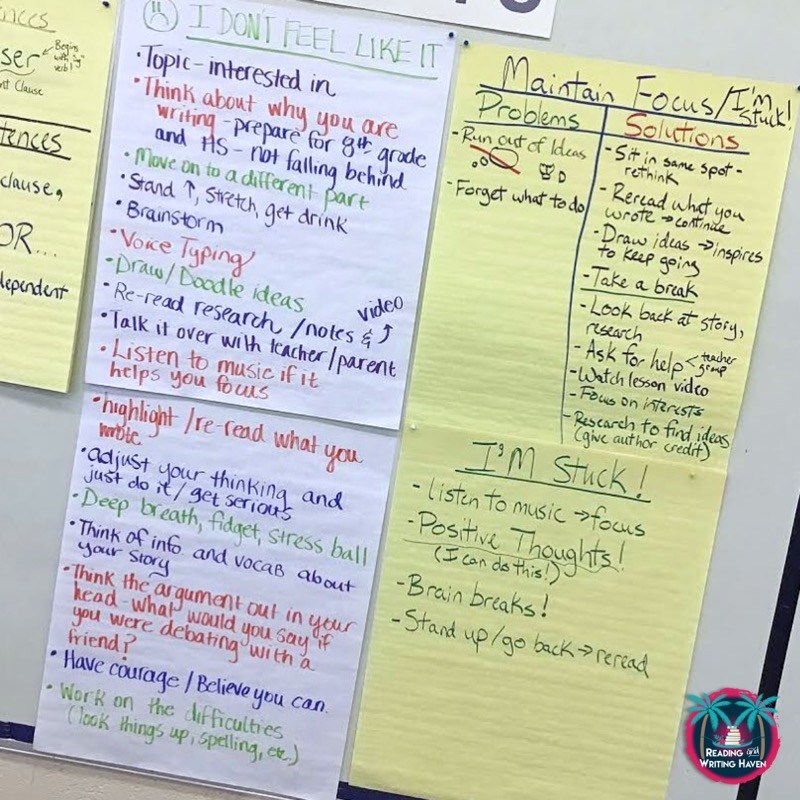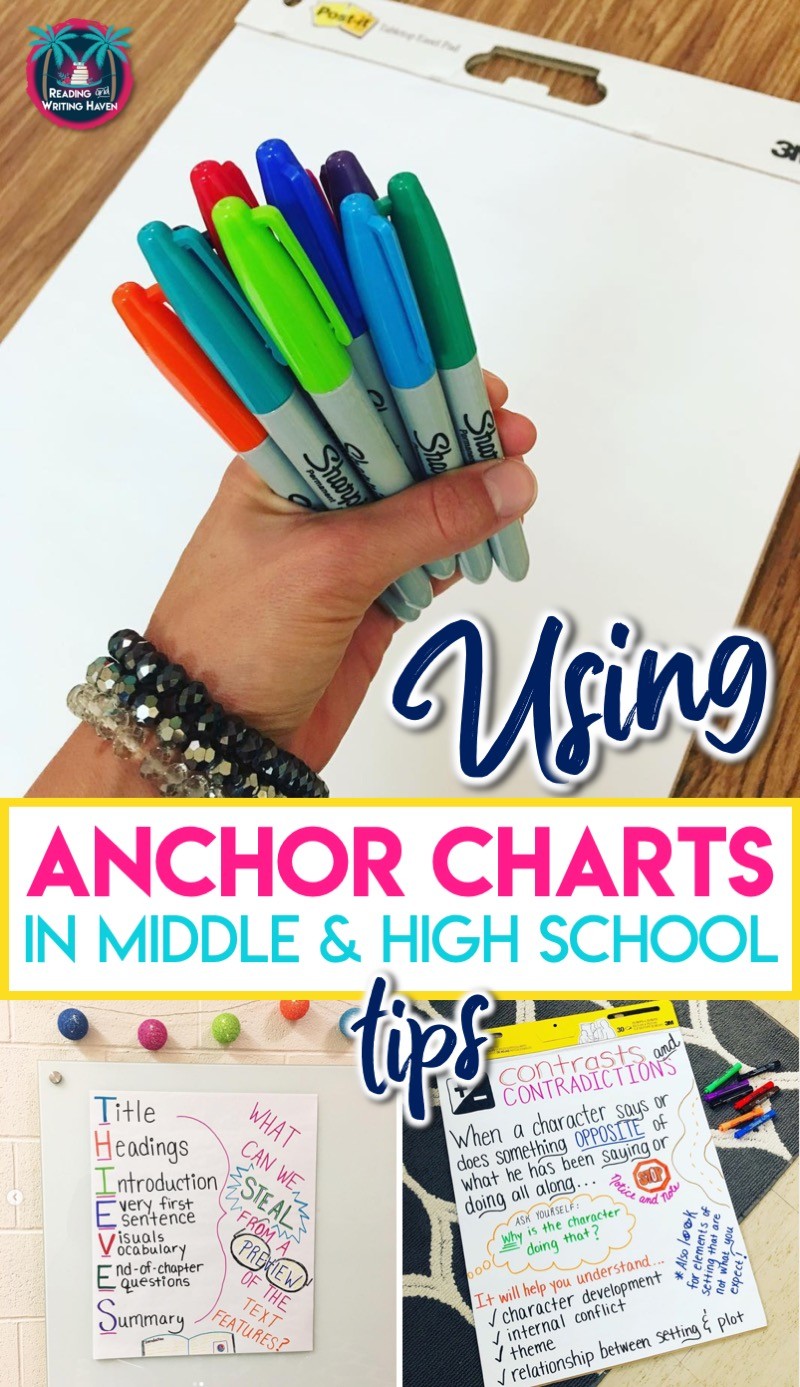Using Anchor Charts in Middle and High School: Why and How
For the longest time, I thought anchor charts were for elementary classrooms. I’d see photos floating around on social media, but I never gave them a second thought in terms of application in a middle or high school classroom. I know I wasn’t alone, as it’s somewhat rare for secondary teachers to talk about using them.
More recently, I’ve come to realize that anchor charts are absolutely appropriate – and beneficial – for a secondary classroom. Let’s explore why we should and how we could be using them.
THE BENEFITS OF ANCHOR CHARTS
Most teachers incorporate mini (or maxi) lessons on a regular basis. As students learn new information, anchor charts are a way to help them ground their learning. Because of the way we create them (more on that later), they help students to synthesize their thinking about an important topic or skill.
Generally, we use anchor charts for information students will need to come back to throughout the year. Often, anchor charts are used with essential standard concepts and related strategies.
With reading, for example, you might create anchor charts for signposts, reading strategies, or text structure. Perhaps you want students to remember sentence types, transitions, or word choice concepts with writing and grammar. You can also create anchor charts for classroom procedures and reading and writing workshop expectations, among a plethora of other options.
Creating anchor charts provides a content-rich classroom decoration piece which serves as a bridge between introductory lessons and practice opportunities. When students use them as a reference, they are reminded of prior learning and can more easily make connections with new information.
Students who appreciate scaffolding, ELL students, and anyone who is learning a brand new concept can benefit from anchor charts.
Bottom line: Anchor charts make learning visible.
TIPS FOR USING ANCHOR CHARTS
The benefits of using anchor charts are clear, but actually implementing them can be more of a gray area. When I first began exploring them, I had a lot of questions. Perhaps you do, too. I’m happy to share my learning.
WHEN TO CREATE THEM
Ideally, anchor charts should be created with students. They need to contribute to the synthesis of information. As you teach your lesson, you can pause and add important information, like definitions, questions students should ask, strategies, and images or symbols.
However, secondary classrooms are fast-paced. Our building only has 44 minute class periods. With tight schedules like these, it’s difficult to stick to idealism. It’s best to create anchor charts with students, but we have to prioritize.
If you’re crunched for time, it’s understandable to create the anchor chart…or an outline for one…in advance. However, I’d suggest still providing opportunities for students to think about what should be included. Otherwise, they’re really more of a poster.
For example, instead of pausing throughout the lesson to add to an anchor chart, which does take time, ask students to create their own version – inspired by yours – afterward. This opportunity allows them to do some critical thinking without extending the mini lesson.
However, I wouldn’t recommend that creating anchor charts in advance be the norm.
MULTIPLE CLASS DILEMMA
In our building, teachers have six sections of the same grade level class. That’s a lot of expensive paper! Plus, what will you do with six very similar anchor charts?
To problem solve, you might design the reference tool on the white board. At the end of each period, take a picture of that class’s creation. Then, combine the best, most memorable elements from each class into one reference chart at the end of the day. This approach is helpful because you can use it to review with students and discuss ideas from other class periods.
Another option is to have students create mini anchor charts that they can keep in their folders, binders, or notebooks. This activity can be spun in many ways. For instance, students can work with groups to encourage critical thinking and discussion.
REUSING THEM FROM YEAR TO YEAR
After all the effort it takes to create them, it can be difficult to fathom only using them during one school year. Anchor charts generally aren’t “reused” year to year. However, they can carry over in a couple ways.
First, you’ll begin to notice patterns. After you get comfortable with creating an anchor chart for a given topic, you’ll know what works and what doesn’t. You’ll have an idea of what must be included because it resonates with students. In other words, by creating and recreating each year, the process will go more smoothly each time.
Also, take photos! When you have anchor charts you love, take photos of them so that you can share them with students as additional references. Sure, if you have room to store them, it doesn’t hurt. But, pulling them out of a closet and using them over and over again undercuts some of the most important learning benefits for students.
MAKING THEM APPEAL TO OLDER STUDENTS
Do anchor charts appeal to older students? Honestly, involving middle and high school students in the process of creating them is an effective way to increase engagement. When they are involved in their learning, the lesson naturally appeals more to them.
Some anchor charts are clearly designed for younger students. Paying attention to color palettes, depth of skills and strategies, and illustrations can help make anchor charts appear more “secondary” style.
If you include people, make them look older! If you include objects, choose things that are relatable to teens whenever possible. And, use examples that are relevant to tweens and teens.
Consider allowing students to add specific elements to the anchor chart during the lesson to magnify ownership.
PRIORITIZING WHICH CHARTS TO CREATE
While anchor charts are beneficial teaching tools, it’s important not to overuse them. If you create an anchor chart for every lesson, where would you put them all? Here are some helpful questions to guide your decisions:
- Is this topic/skill related to an essential or power standard for my class?
- Is this topic/skill something that students tend to struggle with each year?
- Will we be coming back to this topic or skill regularly throughout the year?
- Am I going to want students to connect new learning to this topic or skill?
- Will this anchor chart help my classroom to run more smoothly?
MATERIALS FOR CREATION
When creating anchor charts, teachers have different preferences. One thing to consider is how you want to hang them. Will you attach them with binder clips to string? Will you stick them to the wall? I prefer large Post-It easel pads*, but a lot of teachers use chart paper.
Either way, my favorite markers to use are these and these. I like to have different tip sizes to work with.
BUT I’M NOT ARTSY
Whether you have Pinterest-worthy anchor charts hanging in your classroom or not is of no consequence. You don’t have to have pretty handwriting or amazing illustration skills to create meaningful reference points with your students.
Look! Here is an example of a “non-pretty” anchor chart I made with a co-worker as we were introducing writing workshop expectations.

Students can read these anchor charts. They contain valuable information the class refer back to throughout the year, and it will help the room run more smoothly.
If you happen to have handwriting that is illegible, that would be a problem. In this case, you could have a student scribe the anchor chart for you as you teach the lesson.
What thoughts do you have about creating anchor charts? They’re not just for elementary classrooms. Share any questions or tips you have to offer in the comments below.
+The materials linked in this post are Amazon affiliate links. If you purchase from them, I will receive a small profit at no expense to you.

In my middle school classroom, I’ll start the anchor chart with the title and then add what the students say on large Post It notes to stick on. Then, I’m able to take off those post it’s for my next classes. At the end of the day, I create the chart with all of the information from my students throughout the day.
I love that approach for synthesizing content from multiple classes. Thanks for sharing, Jackie!